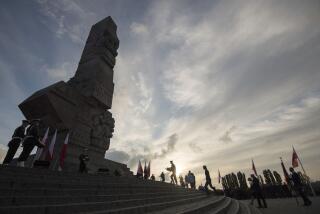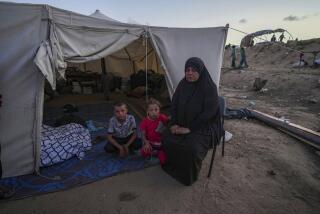HISTORY : 50 Years Later, Dispute Revives Auschwitz Pain : Some Jewish groups say Polish organizers showed insensitivity in plans to commemorate liberation.
OSWIECIM, Poland — Among the grisly reminders of Nazi Germany, none is more horrific than the complex of concentration camps in this southwestern Polish town, known under German occupation as Auschwitz.
Historians estimate at least 1.1 million people from across Europe, the vast majority Jews, were put to death here, most of them in gas chambers disguised as showers, while others were starved, tortured, executed or worked to death.
It was at Auschwitz that Josef Mengele conducted medical experiments on children, and it was here that mounds of corpses were burned in the open because crematories could not keep the murderous pace.
Next week, thousands of survivors return to Auschwitz to mark the 50th anniversary of its liberation by the Soviet Red Army in the closing months of World War II.
But preparations for the commemoration have not gone smoothly, with Polish organizers being accused of insensitivity and incompetence, and the ever-delicate subject of Polish-Jewish relations looming overhead like the heavy winter sky.
“Auschwitz has powerful symbolism, which means emotions run high,” said Stanislaw Krajewski, an adviser to the Auschwitz museum and one of only several thousand Jews remaining in Poland. “It is not easy to satisfy all positions.”
Problems began months ago when plans to include Palestine Liberation Organization leader Yasser Arafat, a 1994 winner of the Nobel Peace Prize, among invited Nobel laureates had to be nixed because of Jewish protests.
And they continued through this week, when several dissatisfied Jewish organizations announced that they will hold their own ceremonies because they felt slighted by the Polish program.
“It is a shame that this has happened,” said Maurice Goldstein, a Belgian Jew who survived Auschwitz and heads the International Auschwitz Committee, the largest survivor organization. “I regret deeply the image the Polish authorities have given the world of this event.”
*
Two days of ceremonies are planned in nearby Krakow, at the main Auschwitz camp in Oswiecim and at the larger “Auschwitz II” camp two miles away in Birkenau, where most prisoners lived and the exterminations took place.
The program calls on the commemorators to issue a worldwide appeal for peace and tolerance, light candles to honor the dead and participate in an ecumenical service. Nobel Peace laureates and political leaders have been invited.
But some Jews have complained that the ceremonies do not sufficiently reflect the depth of Jewish suffering, with the most contentious issue surrounding prayers. The museum estimates that 90% of those killed here were Jewish, but until last-minute changes this week, the program allowed for reciting of the most solemn prayer in Jewish ritual--the Kaddish memorial for the dead--only after official ceremonies had ended.
“A memorial for the dead without recitation of the Kaddish is inconceivable and unacceptable to us,” said Elan Steinberg of the World Jewish Congress. “I was aghast when I saw the program.”
Andrzej Zakrzeski, a top aide to President Lech Walesa and coordinator of the event, said Jewish representatives in Poland had approved the program; he denied that it downplayed the Jewish dimension. The program was designed, he said, to allow all to pray as long as they liked. “Everyone can pray when and where they want,” he said.
The controversy illustrates how little 50 years have done to ease the pain of Auschwitz and reconcile conflicting claims on its legacy. Auschwitz opened in 1940 as a brutal prison camp, mostly for Poles, about 75,000 of whom died here. As such, it carries special meaning in Poland’s tortured past.
Two years later, Auschwitz was converted into the largest Nazi extermination center for Jews, thereby transforming it into the world’s most notorious symbol of anti-Semitism. But it has been only since the fall of communism that Poles have openly acknowledged the magnitude of Jewish losses and that exhibits at the museum have been changed to reflect them.
The first democratic Polish government created an advisory committee of Jews and Polish Catholics to help present a more historically accurate picture. And in 1993, a Roman Catholic convent, under pressure from Jewish groups, was moved from a building next to the original camp in what became a high-profile demonstration of the growing sensitivity to Jewish concerns.
“Things have changed,” Steinberg said, “and hopefully things will continue to change.”
(BEGIN TEXT OF INFOBOX / INFOGRAPHIC)
Terrible Toll
Estimates of the number of people imprisoned and killed at Auschwitz have changed over the years. Here is the most recent esimate of historians at the Polish State Museum Auschwitz-Birkenau, based on Nazi records and witness accounts.
Prisoners Deaths Jews 1.1 million 1 million Poles 140,000 75,000 Gypsies 23,000 20,000 Others* 40,000 15,000
Sources: Figures from Polish State Museum
More to Read
Sign up for Essential California
The most important California stories and recommendations in your inbox every morning.
You may occasionally receive promotional content from the Los Angeles Times.










